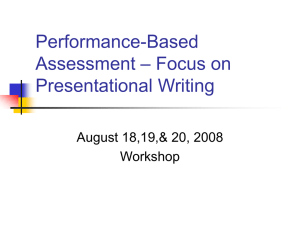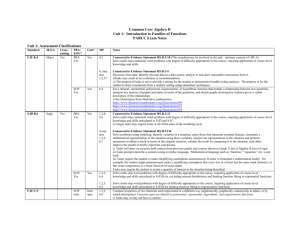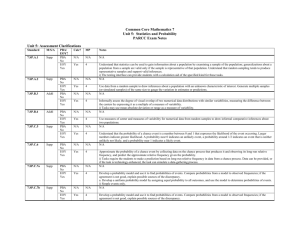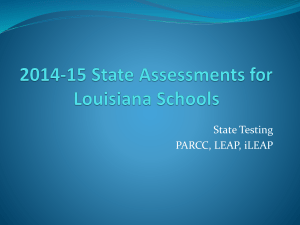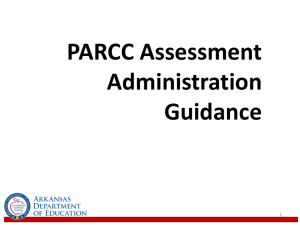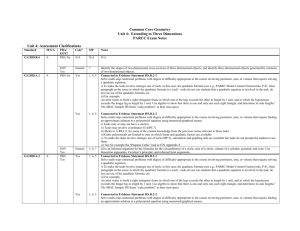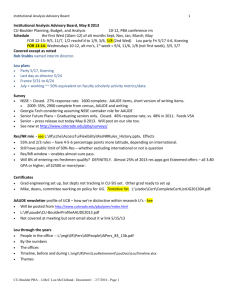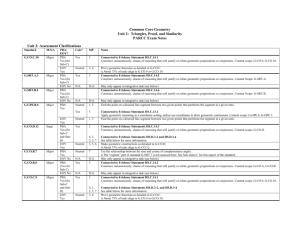04 CCM6 Unit 5 PARCC info
advertisement
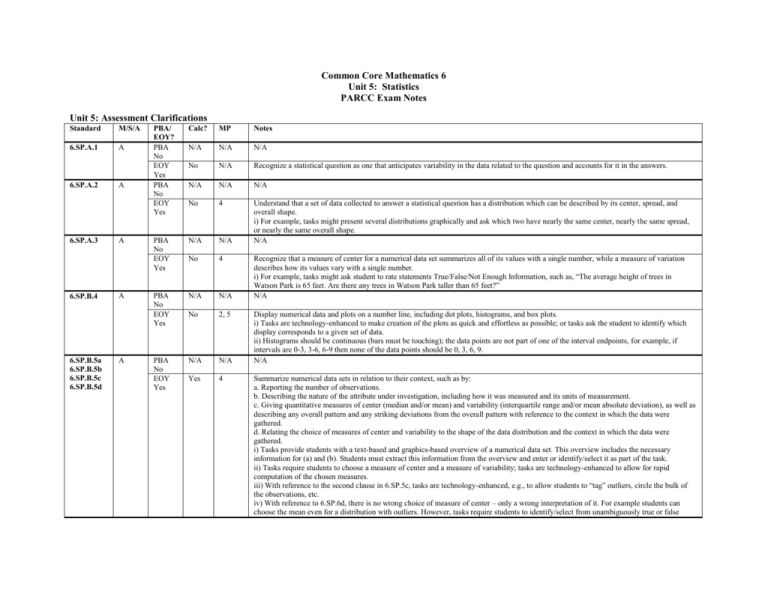
Common Core Mathematics 6 Unit 5: Statistics PARCC Exam Notes Unit 5: Assessment Clarifications Standard M/S/A 6.SP.A.1 A 6.SP.A.2 6.SP.A.3 6.SP.B.4 6.SP.B.5a 6.SP.B.5b 6.SP.B.5c 6.SP.B.5d A A A A PBA/ EOY? PBA No EOY Yes PBA No EOY Yes Calc? MP Notes N/A N/A N/A No N/A Recognize a statistical question as one that anticipates variability in the data related to the question and accounts for it in the answers. N/A N/A N/A No 4 PBA No EOY Yes N/A N/A Understand that a set of data collected to answer a statistical question has a distribution which can be described by its center, spread, and overall shape. i) For example, tasks might present several distributions graphically and ask which two have nearly the same center, nearly the same spread, or nearly the same overall shape. N/A No 4 PBA No EOY Yes N/A N/A No 2, 5 PBA No EOY Yes N/A N/A Yes 4 Recognize that a measure of center for a numerical data set summarizes all of its values with a single number, while a measure of variation describes how its values vary with a single number. i) For example, tasks might ask student to rate statements True/False/Not Enough Information, such as, “The average height of trees in Watson Park is 65 feet. Are there any trees in Watson Park taller than 65 feet?” N/A Display numerical data and plots on a number line, including dot plots, histograms, and box plots. i) Tasks are technology-enhanced to make creation of the plots as quick and effortless as possible; or tasks ask the student to identify which display corresponds to a given set of data. ii) Histograms should be continuous (bars must be touching); the data points are not part of one of the interval endpoints, for example, if intervals are 0-3, 3-6, 6-9 then none of the data points should be 0, 3, 6, 9. N/A Summarize numerical data sets in relation to their context, such as by: a. Reporting the number of observations. b. Describing the nature of the attribute under investigation, including how it was measured and its units of measurement. c. Giving quantitative measures of center (median and/or mean) and variability (interquartile range and/or mean absolute deviation), as well as describing any overall pattern and any striking deviations from the overall pattern with reference to the context in which the data were gathered. d. Relating the choice of measures of center and variability to the shape of the data distribution and the context in which the data were gathered. i) Tasks provide students with a text-based and graphics-based overview of a numerical data set. This overview includes the necessary information for (a) and (b). Students must extract this information from the overview and enter or identify/select it as part of the task. ii) Tasks require students to choose a measure of center and a measure of variability; tasks are technology-enhanced to allow for rapid computation of the chosen measures. iii) With reference to the second clause in 6.SP.5c, tasks are technology-enhanced, e.g., to allow students to “tag” outliers, circle the bulk of the observations, etc. iv) With reference to 6.SP.6d, there is no wrong choice of measure of center – only a wrong interpretation of it. For example students can choose the mean even for a distribution with outliers. However, tasks require students to identify/select from unambiguously true or false statements such as, “About half of the values are greater than the average”; “If this point were deleted from the data set, the median would not change”; etc. v) The testing interface can provide students with a calculation aid of the specified kind for these tasks. Other Integrative Tasks that may be linked to Unit 5 Evidence Statement Reach Back? 6.C.9 5.NBT 5.MD.C 6.D.1 6.D.2 6.D.3 PBA/ EOY ? PBA Calc? MP Notes Yes 3, 6 N/A PBA Yes 4, 1, 2, 5, 7 5.NBT.B 5.NF 5.MD 5.G.A 5.NBT.B 5.MD PBA Yes 4, 1, 2, 5, 7 Distinguish correct explanation/reasoning from that which is flawed, and – if there is a flaw in the argument – present corrected reasoning. (For example, some flawed ‘student’ reasoning is presented and the task is to correct and improve it.) Content Scope: Knowledge and skills articulated in 5.NBT, 5.MD.C Tasks may have scaffolding if necessary in order to yield a degree of difficulty appropriate to Grade 6. Solve multi-step contextual word problem with degree of difficulty appropriate to Grade 6, requiring application of knowledge and skills articulated in the Evidence Statements on the PBA (excludes Reasoning Evidence Statements). Tasks may have scaffolding if necessary in order to yield a degree of difficulty appropriate to Grade 6. Solve multi-step contextual problems with degree of difficulty appropriate to Grade 6, requiring application of knowledge and skills articulated in 5.NBT.B, 5.NF, 5.MD and 5.G.A Tasks may have scaffolding if necessary in order to yield a degree of difficulty appropriate to Grade 6. PBA Yes 4, 1, 2, 5, 7 Reasoned estimates: Use reasonable estimates of known quantities in a chain of reasoning that yields an estimate of an unknown quantity. Content Scope: Knowledge and skills articulated in 5.NBT.B, 5.MD Tasks may have scaffolding if necessary in order to yield a degree of difficulty appropriate to Grade 6. Grade 6 Sub-Claim B Performance Level Descriptors applicable to Unit 5 Statistics and Probability 6.SP.2 6.SP.3 6.SP.4 6.SP.5 Grade 6 Math: Sub-Claim B The student solves problems involving the Additional and Supporting Content for grade/course with connections to the Standards for Mathematical Practice. Level 5: Distinguished Command Level 4: Strong Command Level 3: Moderate Command Level 2: Partial Command Recognizes and describes a statistical Recognizes a statistical question and Recognizes a statistical question and Recognizes a statistical question and question, and understands that a set of understands that a set of collected data understands that a set of collected data understands that a set of collected data collected data has a distribution which has a distribution which can be described has a distribution which can be described has a distribution which can be described can be described by its center, spread by its center, spread and overall shape. by its center, spread and overall shape. by its center, spread and overall shape. and overall shape. Understands the purpose of center and Understands the purpose of center and Understands the purpose of center and Understands the purpose of center and variability and that each can be that it can be summarized with a single that it can be summarized with a single variability and that each can be summarized with a single number. number. number. summarized with a single number. PARCC Abbreviation Key: PBA: Performance-Based Assessment EOY: End of Year Assessment M/S/A: Indicates whether this standard is considered Major content, Supporting Content, or Additional Content MP: Standards for Mathematical Practice * Indicates a modeling standard PARCC Sub-Claims: Sub-Claim A: Information on how PARCC will assess major content Sub-Claim B: Information on how PARCC will assess additional and supporting content Sub-Claim C: Information on how PARCC will assess reasoning Sub-Claim D: Information on how PARCC will assess modeling



